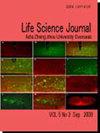Evaluation of Antioxidant Capacities and Total Polyphenols in Various Edible Parts of Capparis spinosa L. Collected from Trans-Himalayas
引用次数: 11
Abstract
The phytochemical screening, antioxidant capacity, and total polyphenols in the methanolic extract of leaves, flower buds, roots and fruits of Capparis spinosa collected from trans-Himalayan region of Ladakh were assessed in an effort to corroborate its medicinal and culinary potential. Highest DPPH and ABTS radical scavenging activity were observed in the leaves and least in dried fruit samples, even FRAP assay also illustrated the same trend. IC 50 values of DPPH assay was highly correlated with that of ABTS (R 2 =0.9084) and FRAP assay (R 2 =0.9771). However, IC 50 value of ABTS was reasonably correlated with FRAP assay (R 2 =0.5838). The highest phenolic and flavonoid content was recorded in the leaf samples (24.78 and 5.69 mg GAE/g DW respectively), whereas it was lowest in the dried fruit samples (4.07 mg quercetin equivalent/g DW and nil, respectively). The total phenolic contents were highly correlated with IC 50 value of ABTS (R 2 =0.9084), DPPH (R 2 =0.9388) and FRAP value (R 2 =0.9618). But, total flavonoid contents were highly correlated with ABTS (R 2 =0.7449), DPPH (R 2 =0.8791) and FRAP values (R 2 =0.9588). Thus, this study has validated the medicinal potential of all the edible parts of the C. spinosa.喜马拉雅地区不同可食部位辣椒抗氧化能力及总多酚含量的评价
对采自拉达克跨喜马拉雅地区的刺毛椒叶、花蕾、根和果实的甲醇提取物的植物化学筛选、抗氧化能力和总多酚含量进行了评估,以证实其药用和烹饪潜力。叶片对DPPH和ABTS自由基的清除活性最高,而干果样品的清除活性最低,甚至FRAP也显示出相同的趋势。DPPH法的ic50值与ABTS (r2 =0.9084)和FRAP法(r2 =0.9771)高度相关。而ABTS的ic50值与FRAP有较好的相关性(r2 =0.5838)。其中,叶样品中酚类和类黄酮含量最高,分别为24.78和5.69 mg GAE/g DW,而干果样品中酚类和类黄酮含量最低,分别为4.07 mg槲皮素当量/g DW和零。总酚含量与ABTS的ic50值(r2 =0.9084)、DPPH (r2 =0.9388)和FRAP值(r2 =0.9618)高度相关。总黄酮含量与ABTS (r2 =0.7449)、DPPH (r2 =0.8791)和FRAP值(r2 =0.9588)高度相关。因此,本研究证实了棘豆所有可食用部分的药用潜力。
本文章由计算机程序翻译,如有差异,请以英文原文为准。
求助全文
约1分钟内获得全文
求助全文
来源期刊
自引率
0.00%
发文量
0
审稿时长
2-4 weeks
期刊介绍:
Life Science Journal, the Acta Zhengzhou University Oversea Version, is an international journal with the purpose to enhance our natural and scientific knowledge dissemination in the world under the free opinion/idea publishing principle. The journal is calling for papers from all the world. All the valuable papers or reports that are related to life sciences - in their broadest sense - are welcome. Other academic articles that are only certain relevant but are of high quality will also be considered and published. Papers submitted could be reviews, objective descriptions, research reports, opinions/debates, news, letters, and other types of writings. All submitted manuscripts will be sent for external peer review and processed the editorial work. After the peer review, the journal will make the best efforts to publish the accepted valuable articles as soon as possible. Let''s work together to disseminate our research results and our opinions/ideas.

 求助内容:
求助内容: 应助结果提醒方式:
应助结果提醒方式:


